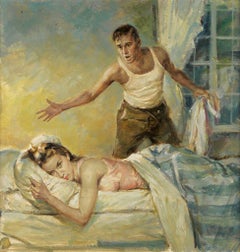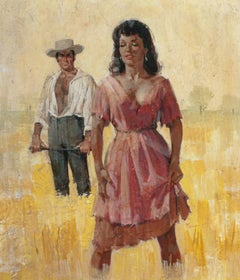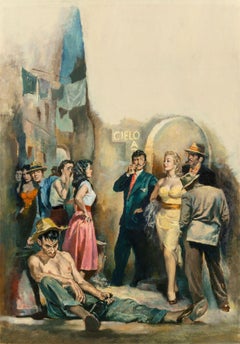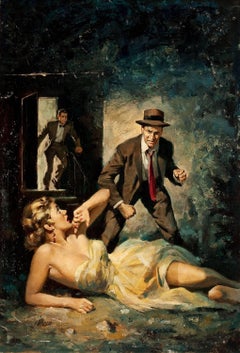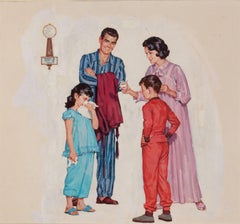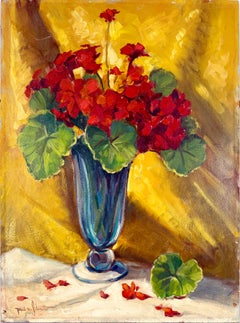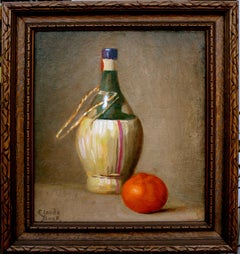James Meese Art
to
2
2
1
Overall Width
to
Overall Height
to
5
4
4
1
5
4
4
2
1
1
5
4
4
1
1
5
10,083
2,777
1,380
1,375
3
5
Artist: James Meese
"The Dangerous Year (The Sunken Garden), " Cover Illustration, 1956
By James Meese
Located in Fort Washington, PA
Medium: Oil on Masonite
Signature: Signed Lower Right, with Title and Registration Marks in Chalk
"Tom pleaded, 'Does one misstep have to ruin our marriage?'" Cover illustration for...
Category
1950s James Meese Art
Materials
Masonite, Oil
On the Plantation, Paperback Cover
By James Meese
Located in Fort Washington, PA
Medium: Oil on Board
Dimensions: 18.00" x 15.50"
Signature: Signed Lower Right
Category
Mid-20th Century James Meese Art
Materials
Board, Oil
Burro Alley, Paperback Cover, 1953
By James Meese
Located in Fort Washington, PA
Medium: Oil on Board
Signature: Unsigned
Dimensions: Sight Size 35.5" x 25.5;" Framed 39.50" x 28.75"
This illustration was published as the paperback cover of Burro Alley by Edwin...
Category
1950s James Meese Art
Materials
Oil, Board
A Bullet for My Love, Paperback Cover
By James Meese
Located in Fort Washington, PA
Date: 1952
Medium: Oil on Board
Dimensions: 23.00" x 16.00"
Signature: Signed Lower Left
This is the paperback cover for A Bullet For My Love by Octav...
Category
1950s James Meese Art
Materials
Oil, Board
Coricidin Cold Tablet Advertisement
By James Meese
Located in Fort Washington, PA
Date: Late 1950s
Medium: Gouache on Board
Dimensions: 16.25" x 17.50"
Signature: Unsigned
Coricidin Cold Tablet Advertisement, Schering Corporation Advertisement
Category
1950s James Meese Art
Materials
Gouache, Board
Related Items
Red Geraniums and Yellow Curtain Original Paul Schmitt California Impressionist
Located in Soquel, CA
Red Geraniums and Yellow Curtain Original Paul Schmitt California Impressionist
Geraniums in an interior setting with a yellow curtain or drape behind by Paul A. Schmitt (American, 18983-1983). Oakland, California artist.
Size 23.5"H x 16.5"W
Signed lower left "Paul A. Schmitt" Exhibition label on verso, "Alameda Art Association, Paul A. Schmitt Oil Still Life No 10"
Painter, watercolorist, illustrator and teacher, Paul Schmitt was born in Philadelphia, in 1893 and moved to San Francisco in 1898 where he lived until the 1906 earthquake took his family home. He then moved to the Fruitvale district of Oakland. He died of natural causes at the age of 90 in San Leandro, California.
Paul Schmitt studied under Perham Wilhelm Nahl, at the California College of Arts and Crafts. He also learned various crafts, woodworking and carving skills from his father, Herman Schmitt, a German wood carver working in San Francisco. Herman's works are still found in various San Francisco public buildings including the city hall chambers and the garden court of the Palace Hotel.
Schmitt joined twelve other local San Francisco artists to form the group called "The Thirteen Watercolorists", a group that eventually evolved into the Society of Western Artists. Their early members included Alfred Owles, Will Cameron, Maurice Logan, Maynard Dixon and many others. Paul worked with engineers and architects doing models of many projects. He was versatile in that he also did illustrations for various publications and advertisers.
He fathered thirteen children. In the late 1930's he decided to accept a teaching position in the local adult schools where he retired in his eighties.
Paul was very fond of the Sierra Nevada Mountains and yearly took his large family there on camping /sketching trips. He did a series of oils of the California missions. He also traveled extensively on sketching trips including Mexico where he did a series of Mexican churches...
Category
1960s American Impressionist James Meese Art
Materials
Masonite, Oil
Paul A. SchmittRed Geraniums and Yellow Curtain Original Paul Schmitt California Impressionist, 1964
$1,150
H 23 in W 16.5 in D 0.07 in
Mid Century Chianti with Orange Still Life
By Claude Buck
Located in Soquel, CA
Still life "Wine with Orange" by Claude (Charles Claude) Buck (1890-1974). Signed lower left. Artist's notes and color scheme on verso. Displayed in rustic giltwood frame. Image, 14"...
Category
1940s American Impressionist James Meese Art
Materials
Masonite, Oil
Mid-Century Modern Figural of Two Women and Child by Harold Kitner Kent State
Located in Soquel, CA
Expressive Mid-Century figural painting of two women and child in pastel hues by Harold Kitner (American, 1921 - 2004).
Image, 33"H x 48"W
Walnut frame, 34"H x 49"W x 2"D
Harold Kitner was born on May 18, 1921 in Cleveland, Ohio and was the son of Isaac and Frieda Kitner. He obtained his MA from Case Western Reserve University in 1947. Kitner was a postgraduate from Cleveland Institute, Ohio University, Cleveland College, Washington and Lee University. He obtained his Doctorate from Kent State University. Exhibition: Harold Kitner - Active / Figure / Exaltation at Kent State School of Art Gallery in Kent, Ohio in 2014.
Harold Kitner taught for over 30 years at the Kent State University School of Art.
Harold Kitner began teaching art and art history at Kent State University in 1947. During his career, he served as Director and Chairman of the Fine Arts Division. Kitner played a significant role in creating the Art School’s core program, organizing the Kent State Arts Festival, and the Blossom Festival School. He also served as President of the Kent chapter of the American Association of University Professors, and was an art critic for the Akron Beacon Journal. In 1967, Kitner became Kent State University’s first Faculty Ombudsman, officially titled Dean for Faculty Counsel. He held this position until 1974. At the time of the Kent State shootings, Kitner’s position as Ombudsman meant that he was involved in many of the decisions regarding University administration in the weeks and months following the Kent State shootings. Kitner began a partial retirement in 1980, and left Kent to become the director of the Institute of the South Florida Art...
Category
1950s Modern James Meese Art
Materials
Masonite, Oil
$2,000 Sale Price
20% Off
H 34 in W 49 in D 2 in
“Village Street” by Mary Nicholena MacCord, American Impressionist European Town
By Mary Nicholena MacCord
Located in Yardley, PA
A wonderful view of a charming European town. This work captures the quiet intimacy of a cobbled lane, its golden stones leading the viewer toward a cluster of whitewashed and brick ...
Category
Early 20th Century American Impressionist James Meese Art
Materials
Canvas, Oil, Board
$2,750
H 26.75 in W 22.75 in D 1.25 in
“Bermuda Coast” Henrietta Dunn Mears American Impressionist Oil on Board Signed
By Henrietta Dunn Mears
Located in Yardley, PA
A vibrant Bermuda seascape depicting the rocky shoreline with turquoise waters breaking against sunlit boulders beneath a sweeping tree. Mears uses bold, textured brushstrokes and a ...
Category
20th Century American Impressionist James Meese Art
Materials
Oil, Board
$1,950
H 19.5 in W 23.5 in D 1 in
Ernst Louizor ( 1938-2011 ) oil painting on board
By Ernst Louizor
Located in Hoddesdon, GB
Ernst Louizor (1938-2011) a beautiful oil painting on board. This vibrant artwork depicts a bustling village scene, elegantly mounted in its original carved wooden frame from Haiti. ...
Category
Mid-20th Century Impressionist James Meese Art
Materials
Oil, Board
$1,650
H 20.87 in W 24.81 in D 1.19 in
Oil painting on board "Rough sea with steamer on the horizon" by S.A.Vinogradoff
Located in Gavere, BE
Sergey VINOGRADOV ( 1869 - 1938 )
Rough sea with steamer on the horizon
Sergei Arsenievich Vinogradov ( Russian: 1869–1938 ) was a Russian-Soviet Impressionist painter; known for l...
Category
1920s Expressionist James Meese Art
Materials
Gold Leaf
$11,410
H 21.26 in W 24.41 in D 2.37 in
trompe l'oeil
Located in GB
The work belongs to the American School of trompe-l’œil painting, a genre that flourished in the 19th century, delighting viewers with illusions of reality. The composition presents ...
Category
20th Century American Realist James Meese Art
Materials
Oil, Board
Art Deco Still Life -- Spring Tulips in Vase
Located in Soquel, CA
Wonderful art deco style still life of yellow and lavender tulips in vase with sugar bowl by Hamlin (American, 20th Century), circa 1935. Signed lower right "Hamlin" Condition: Good;...
Category
1930s Art Deco James Meese Art
Materials
Masonite, Oil
$1,080 Sale Price
20% Off
H 28.5 in W 26.5 in D 1 in
Idle Hour, Impressionist figurative Garden landscape
By Donald Roy Purdy
Located in New York, NY
Idle Hour is an intricately painted Impressionist depiction of woman with her pets on her veranda. It is exquisitely framed in a French Gold Leaf frame of quality and value. Paint...
Category
Late 20th Century Impressionist James Meese Art
Materials
Oil, Masonite
$6,300 Sale Price
30% Off
H 25 in W 28.25 in D 3 in
Charming 1930s Vermont Summer Painting- Laundry Hanging in a Lake House Window
By Harold Haydon
Located in Chicago, IL
A charming, diminutive 1930s Modern painting depicting laundry hanging in a Vermont lake house window by notable Chicago artist Harold Haydon. Artwork size: 8 x 8 1/4 inches. Fram...
Category
1930s American Modern James Meese Art
Materials
Oil, Masonite
$875
H 11.75 in W 12 in D 1 in
Abstract Composition - original painting by Pierre Coquet
Located in Montfort l’Amaury, FR
"A vibrant tapestry of color and texture, celebrating pure abstraction with a dynamic, tactile rhythm."
Pierre Coquet (1926–2021)
Abstract Composition
Oil on board, 44 x 64 x 2 cm (...
Category
1970s French School James Meese Art
Materials
Oil, Board
$3,603
H 17.33 in W 25.2 in D 0.79 in
James Meese art for sale on 1stDibs.
Find a wide variety of authentic James Meese art available for sale on 1stDibs. You can also browse by medium to find art by James Meese in paint, board, oil paint and more. Not every interior allows for large James Meese art, so small editions measuring 16 inches across are available. Customers who are interested in this artist might also find the work of Gladys Rockmore Davis, Walter Martin Baumhofer, and Irene Rice Pereira. James Meese art prices can differ depending upon medium, time period and other attributes. On 1stDibs, the price for these items starts at $1,620 and tops out at $13,200, while the average work can sell for $9,475.
